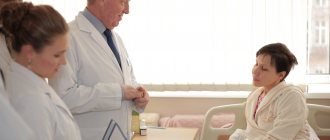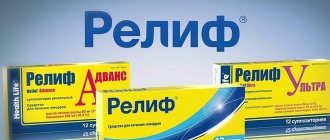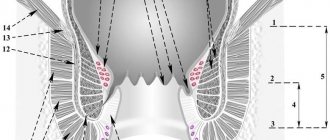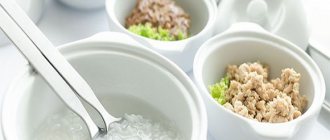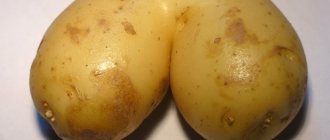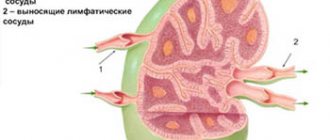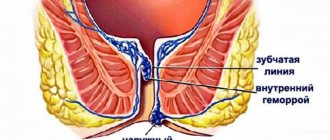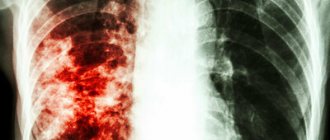Under the mucous layer of the rectum there are the so-called cavernous bodies. This is a network of vessels, which, when filled with blood, creates additional constipation in the anal canal before defecation. These seals also prevent the leakage of intestinal mucus and help differentiate the consistency of the contents - solid, liquid or large amounts of gas.
Unlike varicose veins, when a section of one vessel swells and expands, with hemorrhoids the whole network in the corpus cavernosum suffers. It is the plexus of blood-filled vessels that gives the characteristic appearance of a hemorrhoid lump.
Such formations can appear under the skin around the anus - the so-called external hemorrhoids or under the mucous membrane inside the rectum - the internal form of the disease. According to experts, internal formation of cones is more common. However, with the passage of feces or strong abdominal tension, the internal nodes can move downward, beyond the anus. In addition to the fact that the vascular network is congested with blood, the connective tissue around it no longer holds the lump properly. Slipping and prolapse of hemorrhoids occurs.
Based on the ability to independently return to their original position, hemorrhoids are divided into stages:
- The first is hemorrhoidal cones, which are always located in the anal canal. They are usually painless and occasionally make themselves felt by mild bleeding.
- The second is that defecation can “squeeze” the bumps out, but they return to their original position on their own.
- Third, prolapse is possible in addition to the act of defecation, during coughing, or physical effort. The cones themselves do not retract back, but they can be realigned.
- Finally, the fourth stage - it is impossible to straighten hemorrhoids at home; medical assistance is required.
Stages of node loss
There are several stages of hemorrhoidal prolapse, each of which is characterized by its length and differs from one another depending on its severity. The first is characterized by the loss of a lump during defecation by about 5 centimeters or less. In this case, the knot will straighten on its own.
If a woman is sick during pregnancy or shortly before giving birth, she should consult a doctor at any stage.
The second stage is when the hemorrhoid prolapses by no more than 5-10 centimeters, which looks quite scary. It requires careful reduction; there is no serious reason to see a doctor. The third and fourth stages of node prolapse are considered serious. These stages require immediate treatment; in this case, it is strictly prohibited to reset the lump yourself.
Causes
Treatment of hemorrhoidal cones will be more understandable if you know what factors can lead to their appearance. They affect both men and women.
- Constant high pressure in the veins due to prolonged standing, heavy lifting.
- Difficulty in bowel movement - pressure of stool and effort during defecation.
- Prolonged sedentary work on a hard surface.
- Errors in nutrition, small amount of insoluble fiber and water consumed.
- Family predisposition.
- The added pressure of a baby and hormonal changes during pregnancy are the distinguishing causes of female hemorrhoids.
Self-reduction of the lump
A hemorrhoidal node, which for some reason has come out of the anus, can be reduced at home. This is not to say that this is recommended. If it is adjusted incorrectly, it can be injured or provoke the development of a disease. But if you still decide, you need to follow the following algorithm of actions:
- Thick rubber gloves are put on your hands;
- next you need to squat down or get on all fours - both positions will be quite comfortable;
- With one hand, the left or right buttock is moved to the side; it should be held until the reduction is completed;
- the fingers of the gloved second hand are dipped in rich cream or Vaseline to reduce pain;
- after that you need to try to relax the anal sphincter as much as possible;
- the prolapsed hemorrhoid is reduced into the anus, and it must be removed into the rectum.
If the lump is not returned to the rectum, it may become pinched. This is especially likely if the hemorrhoid itself is bleeding or thrombosed. If everything was not done correctly, you must immediately contact a proctologist. When the procedure is over, you should tighten the sphincter and lie on your stomach for at least half an hour.
What to do if there is a lump in the anus and it hurts?
A lump in the anus is a fairly common phenomenon and, as a rule, once a person discovers such a node in himself, he does not rush to see a specialist.
Of course, you cannot share such a delicate problem with the first person you meet, but it is necessary to visit a doctor and there is no need to delay this visit.
What are these bumps in the anus?
A hemorrhoid is a consequence of an exacerbation of chronic hemorrhoids or a manifestation of a disease such as acute hemorrhoids.
Lumps form near the anus outside or inside the rectum, or they can appear simultaneously inside and outside - this is called “combined hemorrhoids.”
Internal venous nodes may not be immediately noticed because they are painless. Over time, the nodes fall out of the rectum, bringing pain, discomfort and suffering to the patient.
The problem of lumps must be solved immediately, without delaying the visit to the doctor, otherwise the consequences may be unpleasant.
Why are they coming out?
Lumps are formed when the venous wall in the anus is stretched, accompanied by inflammation of the mucous membrane.
They look like empty sacs of stenotic tissue and can lie dormant for a long time until they are filled with blood.
The photo shows what a lump in the anus looks like
will provoke stagnation of a blood clot in the anus or thrombosis of a blood vessel.
The sac fills with blood and, under the influence of internal pressure, increases in size.
This is a hemorrhoidal lump - a dense and painful formation.
The lump interferes with bowel movements, makes it painful, and if you strain during bowel movements, it can fall out of the rectum.
At first, when the cones have not yet reached small sizes, they tend to return to their place on their own after removing the load.
When the disease is not treated and becomes chronic, the nodes remain outside the rectum and require emergency medical intervention.
There are many reasons for the formation of hemorrhoids.
Some of them should be considered:
- impaired bowel movement: frequent constipation or diarrhea;
- poor diet, a lot of fatty, fried, spicy foods, alcohol, strong coffee and tea, carbonated drinks;
- sedentary lifestyle, sedentary work;
- physical activity associated with lifting weights;
- heredity;
- stressful situations;
- gastrointestinal diseases;
- difficult pregnancy and childbirth;
- uncontrolled use of laxatives.
Review your lifestyle and diet. If possible, avoid junk food and monitor the consistency of your stool.
Symptoms of the disease
At the very beginning of its development, the disease makes itself felt with minor signs: itching, movement, the feeling of an unemptied intestine and a foreign object in the anus, discomfort in the anus.
Then burning, pain and fluid discharge from the anus appear. After a bowel movement, traces of blood may be found on toilet paper and underwear.
It is from the formed hemorrhoids, damaged during bowel movements, that bleeding begins.
If you do not start treating hemorrhoids at the initial stage, hemorrhoidal nodes begin to fall out.
They need to be set in place using a cotton pad moistened with petroleum jelly. If the node is not put in place, this can lead to pinching, and this, in addition to severe pain, provokes atrophy of the colon.
With advanced and chronic hemorrhoids, it is no longer possible to straighten the cones. They cause severe pain when defecating, sitting for long periods of time, and even when walking.
A visit to the proctologist at this stage is necessary immediately, since prolapse of the node may be a sign of cancer.
About the purposes of diagnosis and treatment
Only a proctologist can give the patient the correct diagnosis after conducting a comprehensive diagnosis, which is carried out on the recommendation of a specialist and with its full compliance.
The goals of treatment are in two aspects - an accurate diagnosis with the exclusion of dangerous diseases and the determination of treatment methods.
stopvarikoz.net>
Official methods of treatment
Urgent treatment is necessary in the third or fourth stage, and also if it was not possible to independently remove the hemorrhoids located outside. To get competent advice, you need to see a proctologist. Most likely, he will prescribe one of the following methods of therapy. In particularly serious cases, these techniques are combined.
Ring ligation or suture ligation
Full surgical intervention for hemorrhoids does not occur very often. But you can certainly avoid the possibility of the lump falling out again with the help of ligation. The essence of the procedure is that the tumor is tightened with rings or sutures, and blood stops flowing into it. After some time, it dies and is rejected by the body.
The main advantage of this therapy is that it minimizes the treatment time for hemorrhoids.
There are two most effective types of hemorrhoidal ligation: ring and suture. The names themselves indicate the difference between them.
Whatever minimally invasive procedure you choose, you need to remember a number of contraindications and the advantages of each method for removing hemorrhoids:
| Comparison criterion | Circular ligation | Suture ligation |
| Advantages of the method | Modern ring ligation techniques allow the procedure to be completed within 15 minutes. It is completely painless. In addition, immediately after the procedure, the patient can return home and live without any restrictions. | The applied sutures eliminate the flow of arterial blood, which inhibits the development of the disease. The procedure itself does not require pain medication and takes no more than half an hour to complete. |
| Contraindications for this procedure | Ligation is contraindicated when the lump has not yet formed or at the fourth stage of hemorrhoids, as well as in the combined form of the disease, in the presence of anal fissures, paraproctitis in a chronic condition. | Suture ligation cannot be performed if the nodes are not completely formed. It is not performed at the fourth stage of the disease, with mixed hemorrhoids or with problems with blood clotting. |
| Average price for removal of one hemorrhoid node | The price for the procedure is not high, in the capital it will cost 5000-6000 rubles, in the regions the cost is 3500-6600 rubles. | The average price for ligation with sutures in Moscow is 5000-6600; in smaller cities of Russia it can be higher. |
To get rid of hemorrhoid problems, alternative ligation procedures can be performed. These include a new method - vacuum ligation, as well as mechanical removal of the lump with a ligator. They are rarely performed in ordinary clinics, and the potential harm from such procedures may be more serious. Before ligation, be sure to consult with your doctor.
Anti-inflammatory drugs
Pain in the anus can be caused by inflammation of the hemorrhoids. In this case, they noticeably increase in size, therefore, the passage of feces becomes more difficult, and the patient begins to suffer from pain when straining.
It can injure both the external and internal genital organs, or provoke closure of the nerves in the lumbar region. To relieve inflammation, Nimesin, Heparin ointment, Voltaren, Ibuprofen are prescribed.
Venotonics for hemorrhoids
Venotonics are responsible for increasing the tone of the venous muscles, removing blood stagnation, restoring its microcirculation even in the thinnest vessels and helping to strengthen their walls. This reduces the chance of bleeding and infections.
High efficiency was observed in the tablets Detralex, Phlebodia 600, Venarus, Aescusan. Ventonics are not always prescribed: they are most often prohibited during breastfeeding, pregnancy and under the age of 18 inclusive.
Ointments and gels for hemorrhoids
The main indication for the use of antihemorrhoidal ointments or gels is the external form of the disease. However, most products come with an applicator on their packaging. It allows you to easily and painlessly inject the product into the anus.
Therefore, if desired or as directed by a doctor, medications of this type can also be used for standard illness. Most often, Relief, Procto-Glivenol, Posterisan, Troxevasin or Proctosedyl are prescribed.
Antihemorrhoidal suppositories
Rectal suppositories are an ideal solution if the external manifestations of hemorrhoids are located in the rectum. Suppositories reduce the rate of development of the disease and stabilize blood circulation in the affected area.
Some suppositories cause irritation, so they should be prescribed by a specialist who can calculate such risks. Typically, the choice of proctologists falls on suppositories Relief, Proctosedyl, Olestesin, Natalsid, Ultraproct, Anuzol or Procto-Glivenol.
Application of angioprotectors
Angioprotectors are used to strengthen venous walls, as well as improve blood circulation in the affected area. This will allow you to quickly restore the affected tissues, avoid the development of hemorrhoids and the associated pain syndrome.
Typically, the drugs Troxevasin, Troserutin, Vazonit or similar drugs Indovazin, Venolife, Pentoxifylline act as angioprotectors. All of them have a powerful combined composition, thanks to which the effect is achieved in the shortest possible time.
Diet therapy for prolapsed hemorrhoids
Diet is deservedly considered one of the main components in the fight against all manifestations of hemorrhoids. As soon as the lump resolves, you need to start following some nutritional principles. Ideally, even if the disease passes or has already been cured, it is necessary to constantly adhere to the following dietary rules:
- eat five or six times in fractional portions;
- under no circumstances should you go on a diet based on complete abstinence from food;
- as a last resort, follow the intuitive eating model;
- maintain the water balance necessary for health: you need to consume at least 1.5 liters of water per day;
- monitor the quality of the liquid you drink - don’t skimp on mineral water from the store;
- include foods rich in plant fiber in your diet;
- Avoid drinking alcoholic beverages or foods that contain them.
It is equally important to clear your diet of foods that cause constipation or hardened stool consistency. This group includes the following foods: sweets, baked goods made with yeast, fried or smoked meat dishes, hot sauces. You need to be careful when eating white bread, sorrel, grapes, white cabbage, fatty fish, pasta, and hard cheese. If in doubt, consult a proctologist or nutritionist, and ideally, both doctors.
Laxatives
If diet therapy for hemorrhoid prolapse does not help, and the functioning of the intestines and stomach occurs with noticeable interruptions, you need to resort to the use of laxatives. They are also prescribed for chronic constipation, which increases the risk of infection or physical injury to the hemorrhoid.
Typically, proctologists prescribe Microlax, Duphalac, Guttalax, Bisacodyl, Senade or Forlax. You should not abuse them: the drugs destroy the microflora.
Less popular techniques
Modern medicine offers a number of alternative ways to remove hemorrhoids. These include tumor removal with liquid nitrogen, desarterization - that is, ligation of blood vessels - a node or nodes, coagulation with a laser or infrared rays. It is worth noting that these methods are not suitable for advanced stages of the disease. If the patient's condition is critical, he is transferred to surgeons. They, in turn, perform hemorrhoidectomy.
Hemorrhoidectomy is a major operation that causes severe pain. It requires a long recovery period and, unlike the previously described linging, requires anesthesia. Everything should be done to avoid this model of surgical intervention, because it leads to problems with bowel movements and increases the risk of complications from the prolapse of hemorrhoids.
Popular and inexpensive ointments
Before starting treatment for hemorrhoidal disease, you must consult a proctologist. A specialist will help you choose the most effective and good ointment in each specific case.
The best hemorrhoidal ointments that dissolve cones:
- Heparin ointment. The main active ingredient in its composition is the anticoagulant heparin. It reduces blood clotting, thereby improving blood flow through the hemorrhoidal veins. Heparin ointment for hemorrhoids reduces severe swelling. Prevents thrombosis of nodes and promotes their rapid resorption.
- Relief (Ultra, Advance). The ointment includes components of shark liver tissue. It is these components that provide the anti-inflammatory effect. The product promotes rapid healing and resorption of rectal nodes, and also eliminates discomfort in the anal area.
- Proctosedyl. The composition includes a whole complex of active substances: heparin, hydrocortisone, framycetin and esculoside. This complex effectively relieves inflammation and swelling of affected tissues. Prevents the development of hemorrhoidal bleeding, relieves itching and other unpleasant sensations. It has a hemostatic effect, tones and normalizes the elasticity of blood vessels.
- Gepatrombin G. Ointment promotes the healing of damaged tissues by normalizing tissue metabolism and eliminates inflammatory processes. Heparin, which is part of the drug, prevents the formation of thrombotic masses, eliminates swelling and itching.
- Methyluracil ointment. Has a healing effect. Used to treat fissures around the anus and hemorrhoids (external). Stimulates the functioning of the body's immune system.
- Aurobin is a universal remedy against hemorrhoids in the form of a gel, which includes a hormonal component (prednisolone), lidocaine, triclosan and dexpanthenol, as well as a complex of vitamins. The drug has a rapid healing effect, anti-inflammatory, analgesic and bactericidal effect.
- An ointment called Bezornil relieves pain and inflammation. It has a pronounced astringent effect and quickly relieves swelling. This product actively stimulates regenerative processes in damaged tissues.
- Proctosan. The ointment contains lidocaine, bismuth and bufexamate. Effectively relieves inflammation, disinfects and dries damaged skin areas. Relieves itching and swelling well.
- Combined drug Posterisan. Widely used to relieve inflammation and eliminate allergic manifestations. Suitable for eliminating itching and swelling in the anal area. The composition includes microbial cells in an inactivated state, as well as cortisone.
- Troxevasin. The cream facilitates the process of defecation by promoting vein contraction. Restores the elasticity of the vessels of the rectum, has an anti-inflammatory effect, and also effectively eliminates swelling and itching around the anus. Most often used in the presence of external hemorrhoids.
Unconventional treatment
Relying on unconventional treatment alone when trying to cure a hemorrhoid is prohibited. But you can use it with caution in parallel with treatment with real medications. Most often, healers and healers offer microenemas based on herbal decoctions from medicinal plants - chamomile, calendula, yarrow or oak bark, propolis extract, aloe extract, beets or potatoes.
Sometimes special rectal suppositories are made from potatoes, but they are not recommended for use by the medical community.
Baths with potassium permanganate or herbal infusions are also prescribed. Dried flowers are most often used. Together with them, you can smear natural ointments based on lard, mumiyo and honey.
Adherents of traditional medicine use leeches, this method is especially popular when treating men. But hirudotherapy may not lead to stabilization of blood flow. If a burst node bleeds, then it leads to infection. That is why it is important that the procedure is carried out by an experienced specialist.
Prevention methods
At the initial stage of hemorrhoids, you need to think about how to prevent the development of the disease. Patients should follow the previously described diet: it will help improve metabolism and normalize stool.
It is also necessary to increase the average physical activity, but, at the same time, not to overdo it with strength loads.
It is worth reducing the number of hours you spend in a sitting position: this provokes the progression of the disease.
To avoid injury or infection, wash with cool water or use soft, damp paper after each bowel movement. Try to normalize your diet and give up alcohol so you don't have to use laxatives. Their systematic use has a bad effect on stool, destroys the natural microflora and undermines the functioning of the gastrointestinal tract, which negatively affects overall health.
How to treat hemorrhoidal cones?
The main symptom of hemorrhoids are hemorrhoids. They are located near the anus or inside the intestine. Depending on the location, hemorrhoidal cones and nodes are treated with ointments, suppositories, microenemas and lotions.
Along with medications, traditional medicine is also used, which also helps get rid of the disease.
Folk remedies or traditional medicine?
Along with supporters and opponents of a particular treatment method, there are always those who are hesitant. It is important for such people to understand the difference between the medicinal effects and the “work” of various folk remedies.
Let's compare these methods in several ways:
- Compound. Typically, drugs are synthetic chemical compounds. They are foreign to the human body, so you never know what the reaction will be. Herbs, bee products, minerals are of natural origin. Therefore, treatment with them is perceived more calmly by the body. And the risk that an undesirable reaction will occur is minimal.
- Power of influence. Any chemical acts quickly and powerfully. From this point of view, medications are superior to folk remedies and allow you to get rid of symptoms faster. Therefore, if you are not ready to endure pain and discomfort in the anus, you should use pharmaceutical products.
- Side effects. Both groups of remedies—both medicinal and folk—can cause an undesirable reaction in the body. But in the first case, the risk of such manifestations is much higher, and the reactions themselves are much more serious.
- Contraindications. If you open the annotation for any drug, you will definitely see contraindications. It happens that there are much more of them than indications.
For folk remedies, the only serious warning to use is individual intolerance to a particular herb, component of a homemade ointment or beekeeping product.
Some procedures, such as warm sitz baths, are not recommended during pregnancy. Cold treatment is not recommended for inflammatory processes in the genitourinary area.
Will it help or won't it help?
This question always worries the patient who learns about “the most effective remedy that helps everyone get rid of the disease without exception.” At the same time, few people realize that treatment depends on the stage and form of hemorrhoids.
Any folk remedy for the treatment of hemorrhoids is gentle. It will, of course, reduce the manifestations of the disease. But it is hardly worth talking about a miraculous effect in case of advanced disease. Here, even medications do not always help get rid of the problem, let alone weed.
Therefore, the conclusion is that the younger the “age” of the disease, the greater the chance that folk remedies will give the expected effect. And vice versa - if you have been suffering from hemorrhoids for many years, and the nodes have “stepped over” stage 2 or 3, do not try to remove them with the help of herbs, baths, lotions and other folk recipes. They, of course, won’t do any harm, but there’s no point in expecting anything.
The same approach should be taken with regard to complications of hemorrhoids.
When is it not worth wasting time on folk remedies?
Complications from hemorrhoids are not so rare. The most common of them are thrombosis of the cones, pinching of the anal sphincter, inflammation or massive bleeding.
Any of these conditions is accompanied by vivid clinical manifestations. They are unpleasant for the patient and are fraught with dire consequences, for example:
- Death of the cone wall and development of necrosis.
- Spread of infection to tissue near the rectum.
- Massive blood loss - not just leading to anemia, but in severe cases even threatening the patient’s life.
Note! When complications develop, every minute is precious. Therefore, treatment must be fast and intensive. And this can only be done with medications.
Folk remedies for internal hemorrhoids or external cones are not suitable if complications develop. However, they will help get rid of complaints in the initial stages of the disease, so we will still dwell on them in more detail.
How do folk remedies “work”?
Like medications, folk remedies help:
- get rid of pain
- reduce swelling of cones and tissues around them
- heal damage
- stop the bleeding
At the same time, external bumps can be treated with ointments, lotions and sitz baths. The internal ones are hidden in the depths of the anus, so ointment tampons, microenemas and suppositories are suitable for them.
The “medicine” itself is prepared from natural ingredients - herbs, honey, propolis, sea buckthorn oil, clay, beet juice and other components. We will not consider in detail each recipe used for treatment with folk remedies. As an example, we will focus only on the treatment of bleeding - a frequent and sometimes the only symptom of the disease.
Bleeding from a node and folk remedies
Both external and internal nodes can bleed. The easiest way to get rid of bleeding from an external lump is to use cold water, which is always available everywhere. Pour it into a basin and sit in it so that the cone is completely submerged in water. The cold will cause the blood vessels to narrow and the bleeding will stop or at least decrease. Moreover, the pain will dull if there is any.
When it is not possible to take a bath, a cold lotion will help out. Fold a wide bandage into several layers, take a piece of gauze or soft cloth, moisten it with cold water and apply it to the knot. If necessary, periodically wet the cloth and apply it to the lump again until it stops bleeding.
It is more convenient to treat bleeding from the internal lump with ice suppositories, which should be kept in reserve. Making them couldn't be easier. Take a thick sheet of paper or soft cardboard and roll up a “funnel” the size of a pharmacy candle. Pour cold water into it and put it in the freezer. If there is bleeding, remove the ice from the paper, insert the prepared suppository into the anus and leave it in the anus for several minutes.
Note! Any procedures using cold are contraindicated when there is inflammation of the genitals, kidneys or bladder. It is not recommended to treat bumps in this way during pregnancy.
Propolis also has a hemostatic effect due to its ability to cauterize tissue. It needs to be dissolved in water and lubricated external components. And irrigate the internal ones in the depths of the anus using a microenema.
In parallel with local remedies, you can take orally decoctions of hemostatic herbs - nettle, knotweed, yarrow, shepherd's purse. For 1 glass of boiling water, 1 tablespoon of herb is enough. The poured raw material is infused for 30 minutes to 1 hour and filtered. The finished infusion is drunk in equal portions 3-4 times a day.
And finally...
Any disease must be treated by a doctor. A coloproctologist or surgeon deals with hemorrhoids. Only a specialist will correctly determine the stage of the disease, assess the risk of complications, choose a treatment option, or offer to remove the lump.
Non-traditional methods for treating hemorrhoidal cones are really effective, and this has been proven by many years of practice. However, you need to know when to use them and when not to. Indeed, in certain situations, even the best traditional method of treating hemorrhoids is absolutely useless. Then it will not be possible not only to cure the disease, but even to reduce its manifestations.
Moreover, refusing drug therapy or surgical intervention when they are necessary leads to the loss of valuable time. And this is fraught with the development of complications and a longer fight against the disease.
NetGemorroya.ru>
Conclusions about therapy
A timely visit to a proctologist frees you from unnecessary worries about your health and the healing of hemorrhoids. To stop the progression of the disease or protect yourself from it in advance, you need to control your condition, lifestyle and diet.
If prevention did not help, and the hemorrhoid not only formed, but also fell out, you need to assess your own condition. If you suspect stage 3 or 4, contact your doctor immediately. Only a professional physician can choose the right treatment model and combine traditional medicine, procedures and traditional medicines. This combination of measures helps to quickly get rid of even advanced disease.
